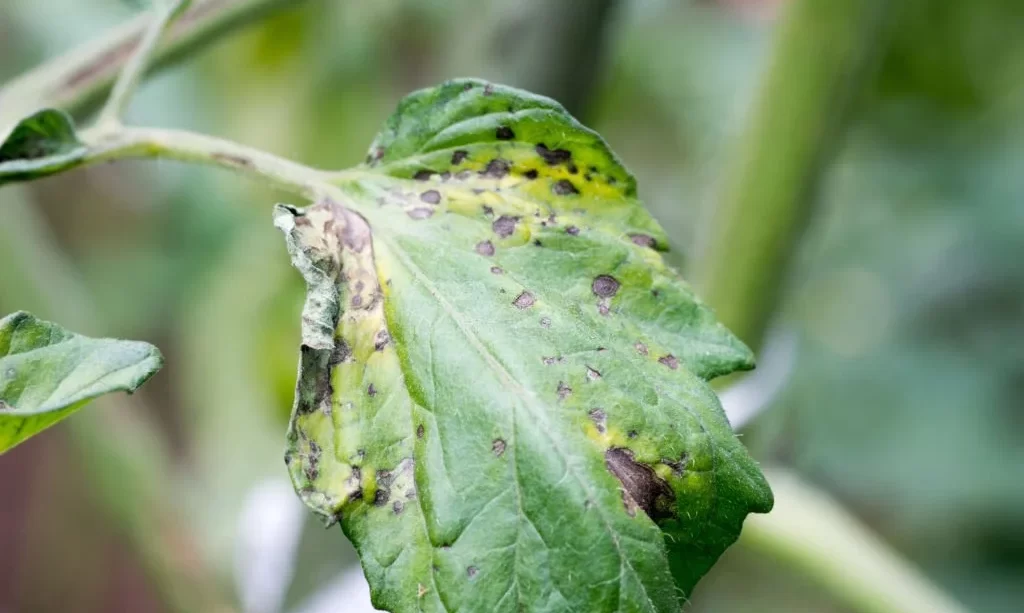In the realm of home gardening, few delights are as rewarding as nurturing tomato plants and eagerly anticipating the vibrant, juicy fruits they promise to bear. However, the joy of growing tomatoes can sometimes be tempered by a common issue that plagues gardeners: black spots on tomato fruits. These dark, unsightly blemishes can mar the otherwise enticing appearance of ripe tomatoes and leave growers wondering about their causes. In this article, we embark on a journey to unravel the mystery behind these black spots and shed light on the factors responsible for their appearance. From fungal diseases that often play a leading role to other potential culprits, we’ll explore the root causes of black spots on tomatoes, empowering gardeners to protect their precious harvests.
- PEST DEFENSE – This product is designed to kill species of aphid, spider mite, ant, cricket, weevil, caterpillar, fly, thrip, silverfish & more.
- CONTROLS FUNGAL DISEASES – Tomato & Vegetable spray controls blackspot, powdery mildew, rust, scab, blight, brown rot, & leaf spot. For best control apply as a spray early in the season before the diseases are noticed.
- INDOOR & OUTDOOR USE – Our insect killer is perfect for use on listed fruits, vegetables, & ornamentals. This includes beans, beets, carrots, cabbage, kale, onions, tomatoes, roses, houseplants, shrubs, almonds, apples, pears, & more.
- CONTACT SPRAY – Pests need to be contacted by the spray to be controlled. We recommend you thoroughly spray all areas of the plant, especially new shoots & the underside of leaves.
- READY TO USE – This product is conveniently ready to use when it arrives at your home. The spray nozzle makes this product easy to deploy.
Fungal Diseases: The Primary Culprits
When it comes to black spots on tomatoes, fungal diseases emerge as the primary culprits, casting a shadow on the beauty of these beloved fruits. Let’s delve into the world of fungal pathogens that often take center stage:
- Fungal Onslaught: Fungal diseases are formidable adversaries for tomato plants. Common fungal culprits behind black spots include early blight (Alternaria solani), late blight (Phytophthora infestans), and Septoria leaf spot (Septoria lycopersici). These pathogens target various parts of the tomato plant, from leaves to fruits, leaving their mark in the form of dark, ominous spots.
- Distinctive Appearance: Black spots caused by fungal infections often exhibit characteristic features. They start as small, dark lesions on tomato leaves, which gradually expand and darken. When these fungi affect tomato fruits, they create sunken, blackened areas that can render the tomatoes unappealing and less suitable for consumption.
- Spread and Severity: Fungal diseases can spread rapidly, particularly in warm, humid conditions. Left unchecked, they can devastate tomato crops and leave gardeners grappling with unsightly, infected produce. Identifying and addressing these fungal foes early is crucial to minimizing their impact on your tomato harvest.
As we journey further into the world of black spots on tomatoes, we’ll explore not only fungal diseases but also other factors that can contribute to this phenomenon. By understanding the causes, gardeners can employ proactive measures to protect their tomato plants and savor the fruits of their labor without the shadow of unsightly blemishes.
Bacterial Diseases: Another Potential Factor
While fungal diseases often take the spotlight in discussions about black spots on tomatoes, bacterial diseases are another potential factor that can contribute to these unsightly marks. Let’s delve into the realm of bacterial culprits:
- Bacterial Infections: Bacterial diseases, such as bacterial speck (Pseudomonas syringae) and bacterial spot (Xanthomonas spp.), can lead to the development of black spots on tomato fruits. These pathogens can enter the plant through wounds, natural openings, or even via contaminated tools.
- Black Lesions: Bacterial infections typically manifest as black or dark lesions on tomato fruits. These lesions may start small but can grow larger and more prominent over time. They often have an irregular shape and can be mistaken for fungal-induced black spots.
- Prevention and Hygiene: Effective prevention of bacterial diseases involves maintaining proper hygiene in the garden. This includes sterilizing gardening tools, avoiding overwatering, and ensuring good air circulation to reduce humidity, which can encourage bacterial growth.
Environmental Factors: Stress and Sunscald
Beyond diseases, environmental factors can also contribute to the appearance of black spots on tomato fruits. Here are two significant environmental considerations:
- Stress from Irregular Watering: Inconsistent watering practices, including both overwatering and underwatering, can stress tomato plants. This stress can manifest as black spots on tomatoes, particularly when fluctuations in soil moisture levels lead to physiological disorders.
- Sunscald: Exposure to excessive sunlight, particularly during scorching summer days, can result in sunscald on tomato fruits. Sunscald causes blackened areas on tomatoes, especially where they receive direct sun exposure. These areas are more susceptible to disease, which can exacerbate the problem.
- Preventive Measures: To combat environmental factors contributing to black spots, gardeners should adopt consistent watering routines to provide steady moisture to plants. The use of mulch can help regulate soil temperature and moisture levels, reducing stress. Additionally, providing shade or using shade cloth during extreme heat can protect tomatoes from sunscald.
By considering both bacterial diseases and environmental factors, gardeners can adopt a holistic approach to prevent and manage black spots on tomatoes. Vigilance, good garden practices, and timely interventions can help preserve the beauty and quality of homegrown tomatoes, allowing gardeners to enjoy blemish-free harvests.
Physiological Disorders: Calcium Deficiency and Blossom End Rot
Black spots on tomatoes can also be attributed to physiological disorders, two of the most common being calcium deficiency and blossom end rot:
- Calcium Deficiency: When tomato plants do not receive adequate calcium, they can develop a condition known as “blossom end rot”. This disorder results in black, leathery lesions at the blossom end of the fruit, which can resemble black spots. Calcium deficiency can occur due to irregular watering, nutrient imbalances, or poor soil quality.
- Blossom End Rot: Blossom end rot is a specific physiological disorder characterized by blackened areas at the bottom of tomato fruits. It is not caused by a lack of calcium in the soil but rather by the plant’s inability to take up calcium due to fluctuations in soil moisture. Inconsistent watering practices can trigger this disorder.
- Prevention: To prevent calcium-related black spots, maintain even soil moisture by watering consistently and ensuring proper drainage. Soil amendments containing calcium may also help address these issues. Applying mulch around plants can help regulate soil temperature and moisture levels.
- FOR USE ON: Use Tomato-tone organic fertilizer for all types of tomatoes; both heirloom and hybrid. It Produces plump, abundant tomatoes, not unwanted foliage. Can also be used on all vegetables.
- CONTAINS: Tomato-tone is a rich blend of the finest natural & organic ingredients enhanced with our exclusive Bio-tone formula; 3-4-6 Fertilizer analysis with 8% calcium to help prevent blossom end rot. Tomato-tone is environmentally Safe – No sludges or toxic ingredients.
- WHEN / HOW TO USE: Best to use Tomato-tone fertilizer every two weeks through the growing season. Apply to the soil around the drip line of the plant and then water thoroughly. Tomato-tone is ready to use and requires no mixing.
- FOR ORGANIC GARDENING: Tomato-tone is approved for organic gardening; It is a registered Organic Input Material meaning it meets all requirements for organic production.
- MADE IN THE USA: Product of the Espoma Company. The leader in natural organics since 1929
Pest Damage: A Lesser-Known Factor
While diseases often take the spotlight, pest damage can indirectly lead to black spots on tomatoes:
- Pest Feeding and Entry Points: Pests such as stink bugs, aphids, and fruit flies can cause damage by piercing the skin of tomato fruits and feeding on their contents. These feeding wounds create entry points for fungal or bacterial infections, which can manifest as black spots.
- Detection and Management: Early detection of pest damage is essential. Implementing pest control measures, such as using insecticidal soaps or physical barriers like row covers, can help protect tomato plants from pest-related issues. By minimizing pest damage, you can reduce the risk of secondary fungal or bacterial infections that lead to black spots.
Conclusion
In the quest to understand the origins of black spots on tomatoes, it becomes evident that multiple factors can contribute to this issue. From fungal and bacterial diseases to environmental stressors, physiological disorders, and even pest damage, the causes are multifaceted.
As gardeners, the key lies in proactive measures to prevent and manage these factors. Maintaining a balanced watering schedule, ensuring proper nutrition, practicing good garden hygiene, and implementing pest control strategies are vital steps in safeguarding your tomato crop against the appearance of black spots.
While the journey to blemish-free tomatoes may present its challenges, armed with knowledge and attentive care, gardeners can savor the taste of homegrown, unblemished tomatoes and revel in the rewards of their gardening efforts.





